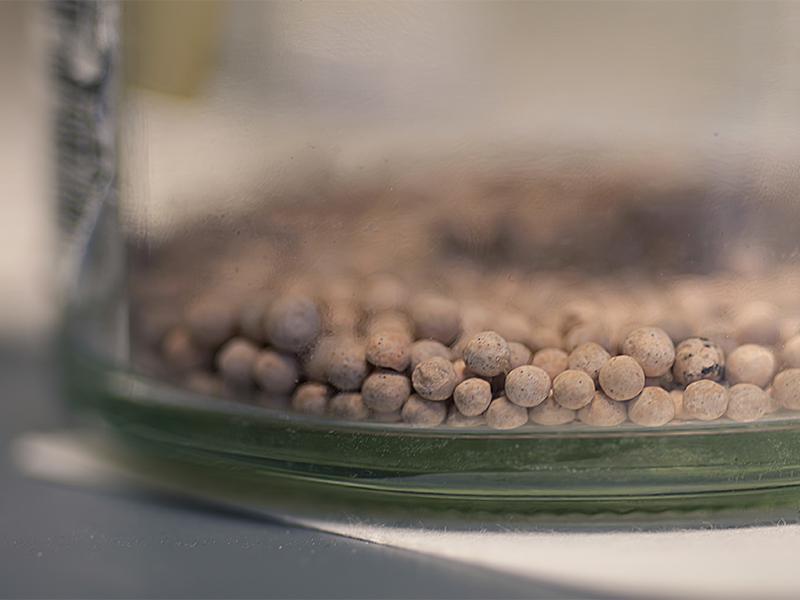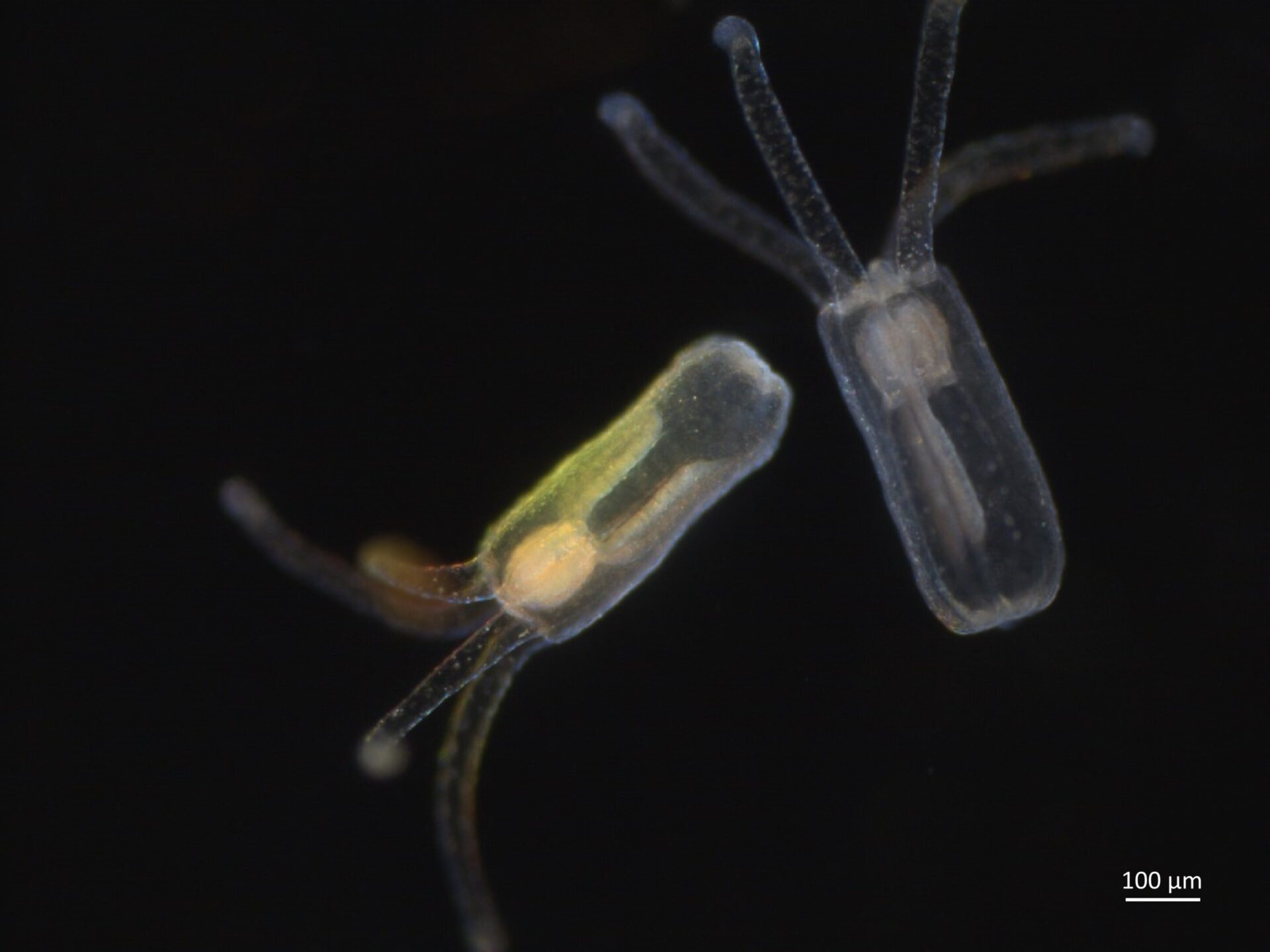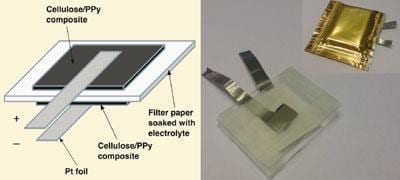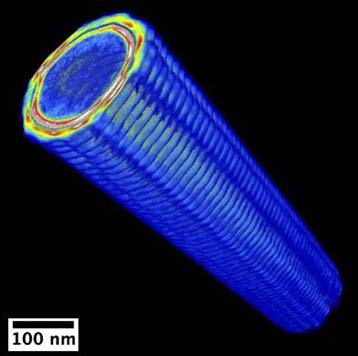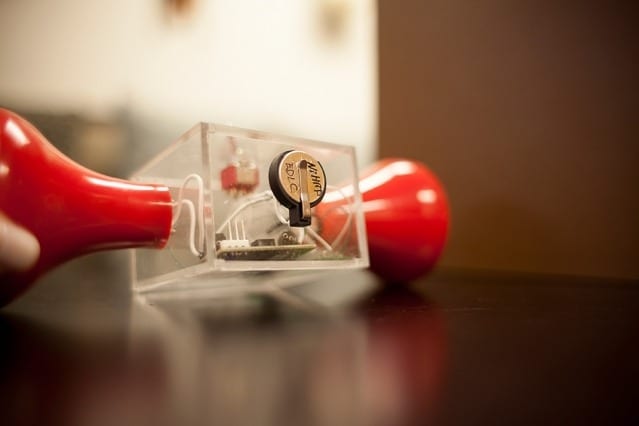
Photo: Melanie Gonick
Energy storage device could deliver more power than current versions of this technology.
Energy storage devices called supercapacitors have become a hot area of research, in part because they can be charged rapidly and deliver intense bursts of power. However, all supercapacitors currently use components made of carbon, which require high temperatures and harsh chemicals to produce.
Now researchers at MIT and elsewhere have for the first time developed a supercapacitor that uses no conductive carbon at all, and that could potentially produce more power than existing versions of this technology.
The team’s findings are being reported in the journal Nature Materials, in a paper by Mircea Dinc?, an MIT associate professor of chemistry; Yang Shao-Horn, the W.M. Keck Professor of Energy; and four others.
“We’ve found an entirely new class of materials for supercapacitors,” Dinc? says.
Dinc? and his team have been exploring for years a class of materials called metal-organic frameworks, or MOFs, which are extremely porous, sponge-like structures. These materials have an extraordinarily large surface area for their size, much greater than the carbon materials do. That is an essential characteristic for supercapacitors, whose performance depends on their surface area. But MOFs have a major drawback for such applications: They are not very electrically conductive, which is also an essential property for a material used in a capacitor.
“One of our long-term goals was to make these materials electrically conductive,” Dinc? says, even though doing so “was thought to be extremely difficult, if not impossible.” But the material did exhibit another needed characteristic for such electrodes, which is that it conducts ions (atoms or molecules that carry a net electric charge) very well.
“All double-layer supercapacitors today are made from carbon,” Dinc? says. “They use carbon nanotubes, graphene, activated carbon, all shapes and forms, but nothing else besides carbon. So this is the first noncarbon, electrical double-layer supercapacitor.”
One advantage of the material used in these experiments, technically known as Ni3(hexaiminotriphenylene)2, is that it can be made under much less harsh conditions than those needed for the carbon-based materials, which require very high temperatures above 800 degrees Celsius and strong reagent chemicals for pretreatment.
The team says supercapacitors, with their ability to store relatively large amounts of power, could play an important role in making renewable energy sources practical for widespread deployment. They could provide grid-scale storage that could help match usage times with generation times, for example, or be used in electric vehicles and other applications.
The new devices produced by the team, even without any optimization of their characteristics, already match or exceed the performance of existing carbon-based versions in key parameters, such as their ability to withstand large numbers of charge/discharge cycles. Tests showed they lost less than 10 percent of their performance after 10,000 cycles, which is comparable to existing commercial supercapacitors.
But that’s likely just the beginning, Dinc? says. MOFs are a large class of materials whose characteristics can be tuned to a great extent by varying their chemical structure. Work on optimizing their molecular configurations to provide the most desirable attributes for this specific application is likely to lead to variations that could outperform any existing materials. “We have a new material to work with, and we haven’t optimized it at all,” he says. “It’s completely tunable, and that’s what’s exciting.”
While there has been much research on MOFs, most of it has been directed at uses that take advantage of the materials’ record porosity, such as for storage of gases. “Our lab’s discovery of highly electrically conductive MOFs opened up a whole new category of applications,” Dinc? says. Besides the new supercapacitor uses, the conductive MOFs could be useful for making electrochromic windows, which can be darkened with the flip of a switch, and chemoresistive sensors, which could be useful for detecting trace amounts of chemicals for medical or security applications.
While the MOF material has advantages in the simplicity and potentially low cost of manufacturing, the materials used to make it are more expensive than conventional carbon-based materials, Dinc? says. “Carbon is dirt cheap. It’s hard to find anything cheaper.” But even if the material ends up being more expensive, if its performance is significantly better than that of carbon-based materials, it could find useful applications, he says.
This discovery is “very significant, from both a scientific and applications point of view,” says Alexandru Vlad, a professor of chemistry at the Catholic University of Louvain in Belgium, who was not involved in this research. He adds that “the supercapacitor field was (but will not be anymore) dominated by activated carbons,” because of their very high surface area and conductivity. But now, “here is the breakthrough provided by Dinca et al.: They could design a MOF with high surface area and high electrical conductivity, and thus completely challenge the supercapacitor value chain! There is essentially no more need of carbons for this highly demanded technology.”
And a key advantage of that, he explains, is that “this work shows only the tip of the iceberg. With carbons we know pretty much everything, and the developments over the past years were modest and slow. But the MOF used by Dinca is one of the lowest-surface-area MOFs known, and some of these materials can reach up to three times more [surface area] than carbons. The capacity would then be astonishingly high, probably close to that of batteries, but with the power performance [the ability to deliver high power output] of supercapacitors.”
Learn more: New kind of supercapacitor made without carbon
The Latest on: Supercapacitor
[google_news title=”” keyword=”supercapacitor” num_posts=”10″ blurb_length=”0″ show_thumb=”left”]
via Google News
The Latest on: Supercapacitor
- HydroGraph to Supply Pristine Graphene to Volfpack Energy for Solar Power Battery Storageon April 30, 2024 at 5:20 am
HydroGraph Clean Power Inc. (CSE: HG) (OTCQB: HGCPF) (the “Company” or “HydroGraph”), a commercial manufacturer of pristine graphene, announced today that its flagship graphene product, FGA-1, has ...
- Scientists design super-battery made with cheap, readily affordable chemical element, Na — Salt-based cell has surprisingly good energy density and charges in secondson April 29, 2024 at 9:50 pm
Researchers at the Korea Advanced Institute of Science and Technology (KAIST) have developed a high-performance, hybrid sodium-ion battery that charges rapidly and offers impressive energy ...
- Rove R2-4K dash cam review: Good captures, GPS, and an appon April 29, 2024 at 8:08 am
The Rove R2-4K is a and affordable, single-channel dash cam with integrated GPS as well as phone connectivity. Captures are good if not the best we've seen.
- Tiny heat pump that relies on changing ambient temperature could be key to powering IoT devices and sensors without batteries forever — Nanoparticles are critical to the ...on April 28, 2024 at 10:46 pm
As IoT technology progresses, the question of how to power these devices, particularly in locations where reliable electrical sources are scarce, presents a significant challenge. Researchers at the ...
- Scientists Uncover Surprising Efficiency of “Messy” Supercapacitorson April 26, 2024 at 10:41 pm
The energy density of supercapacitors, devices similar to batteries that can recharge rapidly in just seconds or minutes, can be improved by increasing the ‘messiness’ of their internal structure. Res ...
- Structural disorder key to high-capacitance carbon electrodeson April 25, 2024 at 1:31 am
Structural disorder increases the capacitance of carbon supercapacitor electrodes, according to new findings from a team of UK-based researchers. The discovery could lead to the development of ...
- Supercapacitor Market CAGR of 23.3%, Unveiling the Enigma Advancements in Deep Understanding through Research Techniqueson April 21, 2024 at 4:16 pm
Request To Download Free Sample of This Strategic Report @- https://reportocean.com/industry-verticals/sample-request?report_id=AMR1042 ...
- New sodium battery that can be charged in seconds developedon April 20, 2024 at 11:01 am
Researchers have developed a high-power hybrid sodium-ion battery that can be charged in seconds, potentially replacing lithium-ion batteries.
- A Supercapacitor From Mushroomson April 1, 2024 at 5:16 pm
The supercapacitor is an extremely promising energy storage technology, and though they have yet to reach parity with the best batteries in terms of energy density, offers considerable promise for ...
via Bing News

